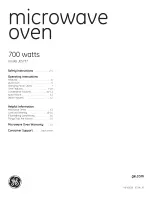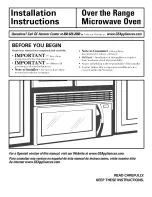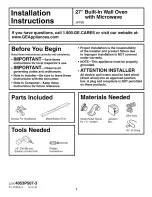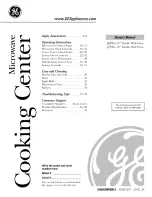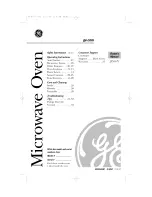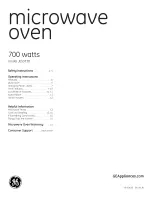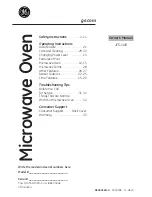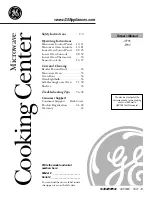
Do not place the microwave oven next to hot areas, for example
gas rings and electric hotplates.
Connecting the microwave oven
The microwave oven must be connected to a 230-volt AC
current, 50 Hz. The guarantee is not valid in the event of
connection to the wrong voltage.
Installation of the glass turntable
Before using the microwave ensure that:
•
the turning ring is fitted to the spindle and that
•
the glass turntable is fitted to the turning ring.
OPERATING THE MICROWAVE OVEN
1.
Place the food in the oven and close the door.
2.
Choose the required microwave power using the top knob
(B) on the operating panel.
3.
Set the timer (A) on the operating panel to the required
cooking time.
The oven starts automatically when you have selected the
microwave power and cooking time.
Once the cooking time has passed, the oven stops automatically
and a signal rings.
Cooking can be interrupted at any time by opening the oven
door. If the oven door is closed again, cooking resumes.
When the oven is not in use, the timer should be at 0.
PREPARATION OF FOOD
When preparing food in the microwave oven, the following basic
rules apply:
Preparation time
Smaller quantities of food are prepared more rapidly than large
quantities. If the amount of food is doubled, the preparation time
must be correspondingly increased to almost twice.
•
Smaller pieces of meat, small fish and chopped vegetables
cook more quickly than large pieces. For the same reason, it
is recommended, if, for example, you wish to make goulash,
stews or similar, that the meat be cut into maximum 2 x 2
cm pieces.
The compactness of the food is also very important for the
cooking time. The more compact the food is, the longer it takes
to cook it.
•
Complete steaks require a longer cooking time than stewed
dishes.
•
A steak requires a longer time than a dish with minced
meat.
The colder the food, the longer the cooking time needs to be.
Food at room temperature will therefore cook faster than food
from a fridge or freezer.
When cooking vegetables, the cooking time depends on the
freshness of the vegetables. Therefore check the condition of the
vegetables, and add or deduct a little time accordingly.
The short cooking time when using a microwave oven means
that the food does not overcook.
•
If required, a little water can be added.
•
When cooking fish and vegetables, you only need to use the
minimum of water.
Microwave power
The choice of power setting depends on the condition of the
food to be cooked.
In most cases, the food is cooked on full power.
•
Full power is used, among other things, for reheating food
quickly, boiling water or similar.
•
Low power is principally used to defrost food and prepare
dishes containing cheese, milk and egg. (Whole eggs in
their shell cannot be cooked in the microwave oven, as
there is a risk of the eggs exploding). In addition, lower
power settings are also used for finish off and for retaining
the excellent aroma of a dish.
Summary of the five power steps:
HIGH (full power)
100 %
M. HIGH (medium-high power)
85 %
MED (medium power)
66 %
M. LOW (medium-low power)
48 %
DEFROST
44 %
LOW (low power)
17 %
General information on cooking
•
If the whole meal is to be prepared in the microwave oven, it
is recommended that you start with the most compact
foods, such as potatoes. Once these are ready, cover them
while the rest of the food is prepared.
•
Most food should be covered. A close-fitting cover retains
the steam and moisture, which shortens the cooking time in
the microwave oven. This is particularly the case when
cooking vegetables, fish dishes and casseroles. Covering
food also distributes the heat better, thus ensuring rapid
and excellent results.
•
In order to achieve the best possible results, it is important
to position the food correctly, as the microwave rays are
most powerful in the centre of the oven. If, for example, you
are baking potatoes, you should position them along the
edge of the glass turntable so that they cook evenly.
•
In order to cook compact dishes such as meat and poultry
evenly, it is important to turn the pieces of meat a few times.
•
You can bake in the microwave oven, although not with
recipes that include yeast.
•
When preparing food in a "traditional" oven, you normally
avoid opening the oven door as much as possible. This is
not the case with a microwave oven: no energy or
significant heat is lost. In other words, you can open the
microwave door and look at the food as often as you want.
Important safety measures when preparing food!
•
If using the microwave oven to heat baby food or liquids in a
feeding bottle, you must always stir the food/liquid and
check the temperature thoroughly before serving. This
ensures that the heat is evenly distributed and avoids
scalding injuries.
The lid and/or teat must not be fitted on a feeding bottle
when it is placed in the microwave oven.
•
If some foods are heated too long, they may char and give
off smoke. If this happens, you should leave the door closed
and switch off the microwave oven completely.
•
Some foods with a low water content, e.g. chocolate in
squares and pastries with a sweet filling should be heated
carefully, otherwise they or the container may be ruined.
19
753067_IM 26/04/07 8:55 Side 19






























